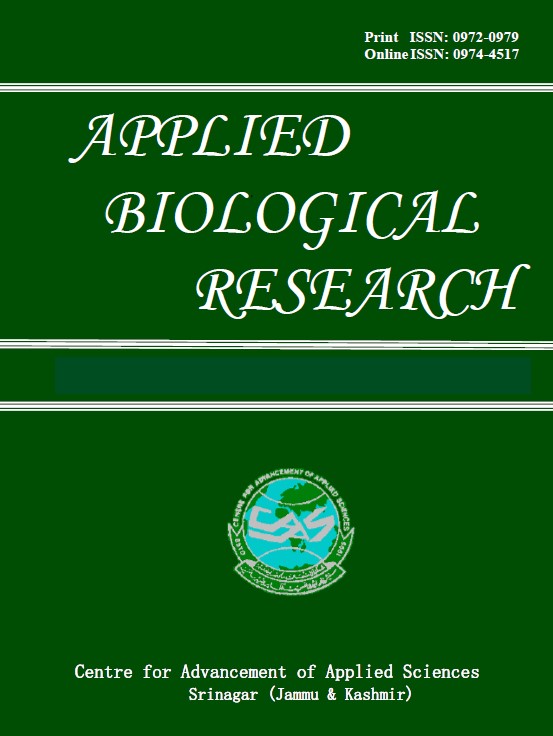ALGAL DIVERSITY IN TEA AND PINEAPPLE PLANTATION SOILS IN MARNGAR, MEGHALAYA (INDIA)
DOI:
https://doi.org/10.48165/abr.2025.27.01.12Keywords:
Algal diversity, physicochemical properties, pineapple plantation, soil, tea plantationAbstract
The algal distribution in farmland depends on the plantation type and soil properties, therefore the present study was aimed to assess the diversity of algal community in soils of tea- and pineapple-plantation soils and to correlate the relationship between algae and soil parameters. Soil samples were collected from tea- and pineapple-plantations every month from April 2022 to May 2023. The soil and algal samples were analyzed by appropriate standard methods. Tea plantation soil was clay loam while pineapple plantation soil was sandy loam. The soil samples from study sites were slightly acidic throughout the season. Significant differences in both the study sites were observed for conductivity, moisture content, water holding capacity, organic carbon and phosphorus content. Some frequently encountered algal species were Calothrix marchica, Oscillatoria limnetica, Phormidium retzii, Chlamydomonas reinhardii, Scenedesmus communis, Scenedesmus dimorphus, Gomphonema parvulum, and Navicula lanceolata. A total of 63 algal species were recorded from both the sites. Maximum species diversity was observed in tea plantation soil with diversity index of 2.56. Higher algal abundance was noted in the root zone of tea plantation. The soil physicochemical parameters and plantation type significantly influenced the occurrence, composition and abundance of algae in tea- and pineapple-plantation soils.Downloads
References
Abinandan, S., Subashchandrabose, S.R., Venkateswarlu, K. and Megharaj, M. (2019). Soil microalgae and cyanobacteria: The biotechnological potential in the maintenance of soil fertility and health. Critical Reviews in Biotechnology, 39: 981–998.
Adesalu, T.A. and Olugbemi, O.M. (2015). Soil algae: A case study of two vegetable farmlands in Lagos and Ogun states, South West Nigeria. Ife Journal of Science, 17: 765–772.
Aggarwal, A. (2020). Algae for soil regeneration. IOSR Journal of Environmental Science, Toxicology and Food Technology, 14: 38–40.
Agha, Q., Asrar, M., Leghari, S.K. and Somalani, M.A. (2020). Algae soil fertility and physicochemical properties in agricultural fields of Balochistan, Pakistan. Pakistan Journal of Botany, 52: 1491–1495.
Allen, S.E., Grimshaw, H.M., Parkinson, J.A. and Quarmby, C. (1974). Chemical Analysis of Ecological Materials. Blackwell Scientific Publications, Oxford, UK.
Alvarez, A.L., Weyers, S.L., Goemann, H.M., Peyton, B.M. and Gardner, R.D. (2021). Microalgae, soil and plants: A critical review of microalgae as renewable resources for agriculture. Algal Research, 54: 102200. [https://doi.org/10.1016/j.algal.2021.102200].
Anderson, J.M. and Ingram, J.S.I. (1993). Tropical Soil Biology and Fertility: A Handbook of Methods. CABI, Wallingford, UK.
Bohlen, P.J., Groffman, P.M., Driscoll, C.T., Fahey, T.J. and Siccama, T.G. (2001). Plant-soil microbial interactions in a Northern Hardwood Forest. Ecology, 82: 965–978.
Bouyoucos, G.J. (1962). Hydrometer method improved for making particle size analysis of soils. Agronomy Journal, 54: 464–465.
Carvalhido, V., Bessa da Silva, M., Santos, M., Tamagnini, P., Melo, P. et al. (2021). Development of an ecotoxicological test procedure for soil microalgae. Science of the Total Environment, 783: 147006. [https://doi.org/10.1016/j.scitotenv.2021.147006].
Chamizo, S., Mugnai, G., Rossi, F., Certini, G. and De Philipps, R. (2018). Cyanobacteria inoculation improves soil stability and fertility on different textured soils: Gaining insights for applicability in soil restoration. Frontiers in Environmental Science, 6: 49. [https://doi.org/10.3389/fenvs.2018.00049].
Deepthi, A.S. and Ray, J.G. (2018). Endophytic diversity of hanging Velamen roots in the epiphytic orchid Acampe praemorsa. Plant Ecology Diversity, 11: 649–661.
Desikachary, T.V. (1959). Cyanophyta. Indian Council of Agriculture Research, New Delhi, India.
Dirborne, C.M. and Ramanujam, P. (2017). Diversity and ecology of soil algae in broadleaf sacred grove and pine forest in east Khasi hills, Meghalaya. Nelumbo, 59: 195. [https://doi.org/10.2032/nelumbo/v59/2017/120460].
Dirborne, C.M. and Ramanujam, P. (2018). Diversity of algae in the farmlands of Khasi hills, Meghalaya. International Journal of Development Research, 8: 20000–20006.
Gabriel, A., Venancio, C., Sousa, J.P., Leston, S., Ramos, F., Soares, A.M.V.M., et al. (2023). Soil pH matters in the ecotoxicity of Basamid® to freshwater microalgae and macrophytes. Science of the Total Environment, 859: 160–165.
Gandhi, H.P. (1998). Freshwater Diatoms of Central Gujarat with a Review and Some Others. Bishen Singh Mahendra Pal Singh, Dehradun, India.
Glaser, K., Baumann, K., Leinweber, P., Mikhailyuk, T. and Karsten, U. (2018). Algal richness in BSCs in forests under different management intensity with some implications for P cycling. Biogeosciences, 15(13): 4181–4192.
Graham, E.B. and Knelman, J.E. (2023). Implications of soil microbial community assembly for ecosystem restoration: Patterns, process and potential. Microbial Ecology, 85: 809–819.
Guillard, R.R.L. (1975). Culture of phytoplankton for feeding marine invertebrates. In: Culture of Marine Invertebrate Animals. Plenum Press, New York, USA. pp. 26–60.
Gyaneshwar, P., Kumar, N.G., Parekh, L.J. and Poole, P.S. (2002). Role of soil microorganisms in improving P nutrition of plants. Plant Soil, 245: 83–93.
Hawkins, E., Fulton, J. and Port, K. (2017). Using Soil Electrical Conductivity to Delineate Field Variation. Oxford Publishers, Oxford, UK.
Hifney, A.F., Issa, A.A. and Mohammed, A.A.A. (2004). Distribution pattern of algae in the root zone of some Egyptian plants at Assiut region, Egypt. Journal of Union Arab Biologists Cairo, 15: 81–99.
John, D.M., Whitton, B.A. and Brook, A.J. (2002). The freshwater algae flora of the British Isles. In: Identification Guide to Freshwater and Terrestrial Algae. Cambridge University Press, Cambridge, UK. pp. 878–880.
Joseph, J. and Ray, J.G. (2024). A critical review of soil algae as a crucial soil biological component of high ecological and economic significance. Journal of Phycology, 60: 229–253.
Krishnamurthy, V. (2000). Algae of India and Neighbouring Countries I. Chlorophycota. Oxford and IBH Publishing Co., New Delhi, India.
Lin, C., Chou, T. and Wu, J. (2013). Biodiversity of soil algae in the farmlands of mid-Taiwan. Botanical Studies, 54: 1–12.
Mukherjee, M., Chakraborty, S., Sarkar, S., Saha, S., Majumder, S., Ghosh, A., et al. (2020). Soil nutritional status of tea plantations in plains of sub Himalayan West Bengal, India. Current Agriculture Research Journal, 8: 239–246.
Nisha, R., Kaushik, A. and Kaushik, C.P. (2007). Effect of indigenous cyanobacterial application on structural stability and productivity of an organically poor semi-arid soil. Geoderma, 138: 49–56.
Oliveira, M.F. and Maciel-Silva, A.S. (2022). Biological soil crusts and how they might colonize other worlds: Insights from these Brazilian ecosystem engineers. Journal of Experimental Botany, 73: 4362–4379.
Prescott, G.W. (1982). Algae of the Western Great Lakes Area. Koelts Science Publishers, Koenigstein, West Germany.
Quilchano, C. and Maranon, T. (2002). Dehydrogenase activity in Mediterranean forest soils. Biology and Fertility of Soils, 35: 102–107.
Saxena, M.M. (1990). Environmental Analysis: Water, Soil and Air. Agro-Botanical Publishers, India.
Singh, S., Pandey, A., Kumar, B. and Palni, L.M.S. (2010). Enhancement in growth and quality parameters of tea (Camellia sinensis L.O. Kuntze) through inoculation with arbuscular mycorrhizal fungi in an acid soil. Biology and Fertility of Soils, 6: 427–433.
Stanier, R.Y., Kunisawa, R., Mandel, M. and Cohen-Bazire, G. (1971). Purification and properties of unicellular blue-green algae (order Chroococcales). Bacteriological Reviews, 35: 171–205.
Stein, J.R. (1980). Handbook of Phycological Methods: Culture Methods and Growth Measurements. Cambridge University Press, Cambridge, UK.
Wei, L., Zhao, Q., Chen, X., Sun, Q., Zhang, X. and Chen, Y. (2023). Seasonal variation in soil algal community structure in different forest plantations in subtropic China. Frontiers in Plant Science, 14: 1–12.
Wilson, L.T. (2006). Cyanobacteria: A potential nitrogen source in rice fields. Texas Rice, 6: 9–10.
Zancan, S., Trevisan, R. and Paoletti, M.G. (2006). Soil algae composition under different agro-ecosystems in North-Eastern Italy. Agriculture, Ecosystems and Environment, 112: 1–12.

